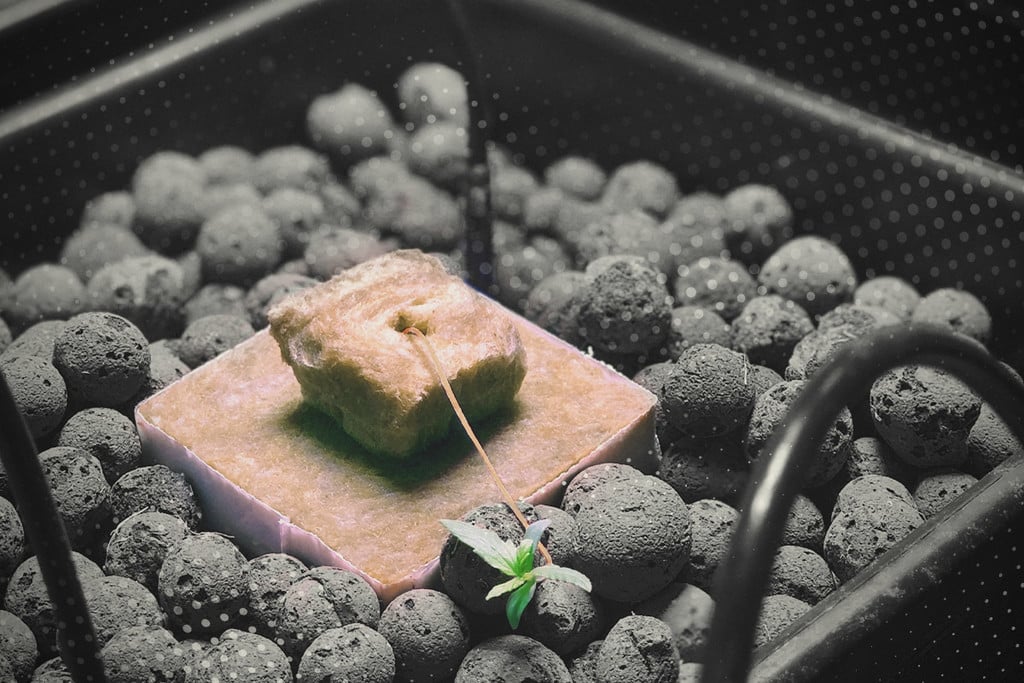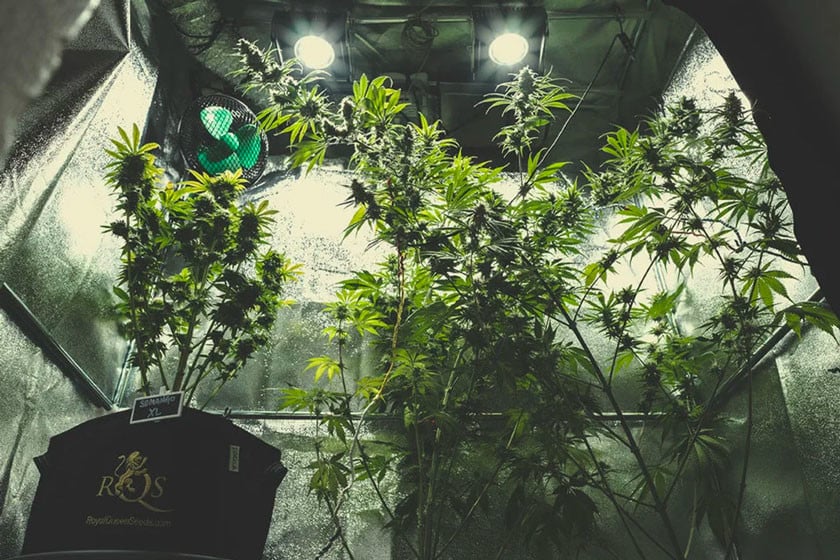 Cannabis Grow Guide by Royal Queen Seeds
Cannabis Grow Guide by Royal Queen Seeds
- Growing cannabis step by step
- Cannabis growing basics
- Choosing your seeds
- How to germinate seeds
- The cannabis vegetative stage
- The cannabis flowering stage
- Harvesting cannabis
- Trimming, drying, and curing
- Choosing pots and soil
-
Growing indoors
- A Complete Overview Of Growing Cannabis Indoors
- Cannabis Cultivation Tips: How To Set Up Indoor Grow Lights
- How Many Cannabis Plants Can You Grow Per Square Metre?
- Indoor Cannabis Growing: Relative Humidity and Temperatures
- Hydroponics Cannabis Growing Guide (with diagrams)
- Cannabis Micro Growing: Growing Great Weed in Tiny Spaces
- Growing outdoors
- How to grow autoflowering cannabis
- Cannabis nutrients and pH
- Cannabis troubleshooting: Nutrients
-
Cannabis troubleshooting: Growing
- Cannabis Seed Germination — Troubleshooting Guide
- How to Deal With Pythium (Root Rot) in Cannabis Plants
- Slow Cannabis Plant Growth And What You Can Do About It
- How to Deal With Leggy Cannabis Seedlings
- Watering Your Cannabis: How to Fix Overwatering and Underwatering
- Understanding Male, Female, And Hermaphrodite Cannabis
- Identifying and Treating Common Cannabis Ailments
- How To Revive a Sick Cannabis Plant
- How to Avoid Mouldy Weed During Drying and Curing
- How to Prevent and Treat Dry and Crispy Cannabis Leaves
- What Cannabis Leaves Can Tell You
- Causes and Solutions for Yellow Cannabis Leaves
-
Cannabis Strains Grow Report
- HulkBerry Automatic Grow Report
- Blue Cheese Auto Grow Report
- Purple Punch Automatic Strain Grow Report
- Triple G Automatic Grow Report
- Do-Si-Dos Automatic Grow Report
- Green Gelato Automatic Grow Report
- Haze Berry Automatic Grow Report
- Purple Queen Automatic Grow Report
- Cookies Gelato Automatic Grow Report
- Sherbet Queen Automatic Grow Report
- Sweet Skunk Automatic Grow Report
- Medusa F1 Grow Report
- Cannabis plant training
-
Weed growing tips
- The Cannabis Plant Anatomy
- How to preserve seeds
- How Much Sunlight Do Outdoor Cannabis Plants Need To Grow?
- How to Control and Prevent Stretching in Cannabis Plants
- My Cannabis Plants Are Growing Too Tall: What Should I Do?
- Should You Worry About Purple Or Red Cannabis Stems?
- What To Do When Your Indoor Cannabis Won’t Flower
- How To Protect Your Cannabis Plants From Heat Stress
- How To Tell If Your Female Cannabis Plant Has Been Pollinated
- Growing Medical Marijuana
- Bud Washing: How to Clean Your Weed
- Understanding Cannabis Yield per Plant

Watering Your Cannabis: How to Fix Overwatering and Underwatering
Key Points
- Overwatering and underwatering produce various symptoms in cannabis plants, including stunted growth.
- Overwatering leads to wet and soggy soil, limp leaves that curl downwards, and rotten roots.
- Underwatering causes leaves to become yellow, dry, and crispy.
- Discover how to prevent and fix overwatering and underwatering below.
Contents:
- Recognising overwatering symptoms in cannabis plants
- Recognising underwatering symptoms in cannabis plants
- Overwatering vs underwatering: key differences
- How often do you need to water your weed plants?
- How to fix overwatered cannabis plants
- How to fix underwatered cannabis plants
- Water quality is paramount
There are many factors involved when it comes to a successful and bountiful cannabis grow. Lighting, nutrients, airflow, and humidity all play important roles in the optimal growth and vibrancy of a crop. Water, however, is one of the most important aspects of keeping cannabis plants healthy and strong.
However, watering isn’t always as simple as it may seem. Many growers are under the impression that completely saturating their crops with water each day is all it takes to help plants obtain their requirements. The truth is, there is much more to the watering process.
Watering cannabis plants is a balancing act that takes some time and experimentation to perfect. Too much water can lead to some serious problems for plants and may obstruct oxygen intake. On the other end of the spectrum, too little water can lead to extremely dry conditions that leave cannabis plants thirsty, eventually causing them to wilt.
Below, you’ll learn how to recognise if you are overwatering or underwatering, and how to fix both situations.
Recognising Overwatering Symptoms in Cannabis Plants
Overwatering is an easy mistake to make when growing cannabis, and is often caused by overzealous growers worried that their plants need constant hydration. It's a pitfall that beginners, especially, fall victim to.
Cannabis plants actually use their root systems to breathe air, in addition to uptaking water and nutrients. If their roots are constantly soaked, they will begin to drown.
The first step to remedying overwatered cannabis plants is to detect the symptoms of the condition. Check out the key signs to keep an eye on below.
Signs of Overwatered Cannabis Plants
The chief signs of overwatered cannabis plants include:
- Drooping leaves: Excess moisture in the soil reduces oxygen intake, interfering with transpiration and causing leaves to lose their turgidity and become limp.
- Yellowing leaves (chlorosis): Inhibited nutrient uptake causes deficiencies, which in turn cause leaves to yellow.
- Curling leaves: Excess water causes stress in cannabis plants, resulting in a “claw-like” appearance in leaves as they curl downwards.
- Slow growth: Too much water impacts physiological processes that plants need to grow properly, resulting in slowed and stunted development.
- Fungal growth: Overly wet soil can cause an increase in humidity in the growing environment, creating ideal conditions for fungal pathogens, such as powdery mildew, to thrive.
- Soaked soil: Of course, highly saturated soil itself is a key indication of overwatering. Growers can insert their finger into the top 3 cm of soil, or opt for the lift-the-pot method, to assess for excess moisture. Ideally, this top layer of the soil shouldn’t feel sodden, and water shouldn’t pool underneath the growing containers.

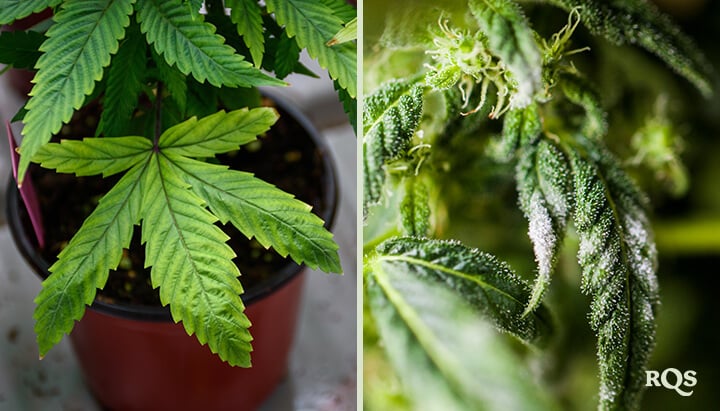
Root Issues in Overwatered Seedlings
Roots are largely ignored by cannabis growers because, unlike the aerial parts of plants, they remain out of sight. However, roots play a fundamental part in plant health and physiology, from synergising with friendly microbes to obtain nutrients, to uptaking oxygen and water.
Because of their vital functions, plant health quickly plummets when roots are impacted. Overwatering essentially suffocates cannabis roots, preventing them from absorbing the nutrients, microbes, and oxygen that plants need to survive and thrive.
Seedlings are particularly prone to overwatering, which causes root rot and “damping off”, leading to them collapsing onto the soil. When exposed to excess water for a long period, they develop darkened root tips, become slimy, and develop a foul smell.
Recognising Underwatering Symptoms in Cannabis Plants
Too much water can certainly cause damage to cannabis plants, but too little also wreaks havoc on plant vigour, growth, and yields. Explore the signs of underwatering below and the factors that contribute to this condition.
Signs of Underwatered Cannabis Plants
The key signs of underwatered weed plants include:
- Wilting: Without ample amounts of water, leaves lose their turgidity from water pressure and start to wilt.
- Dry, crispy leaves: The inability to transport sufficient water to leaf tissues causes the edges and tips of leaves to turn dry and crispy.
- Discolouration: Water scarcity triggers plants to prioritise newer growth, causing older leaves to turn yellow or brown.
- Slow growth: Reduced water intake reduces metabolic activities including nutrient uptake and photosynthesis.
- Leaf curl: Fan leaves tend to curl upwards or inwards when plants are underwatered.
Environmental Factors That Contribute to Underwatering
Underwatering typically stems from several factors, including:
- Insufficient watering: Though uncommon, simply not watering enough can indeed cause plant problems.
- Excess heat: Prolonged high temperatures increase water evaporation and cause soil to dry out.
- Undersized pots: Containers that are undersized dry out much quicker and don’t hold enough water in the soil to accommodate larger strains.
- Improper growing medium: A growing medium too high in sandy soil and substances such as perlite and vermiculture drain too quickly, causing them to dry out much faster.
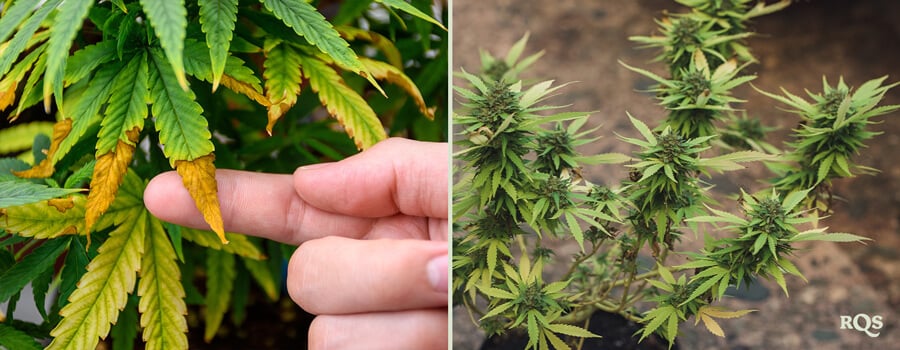
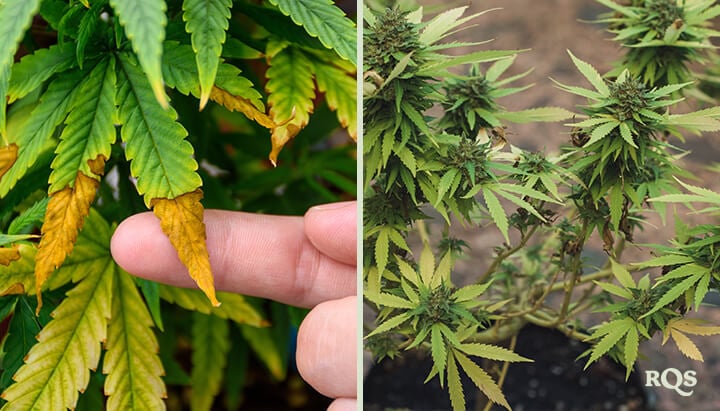
Overwatering vs Underwatering: Key Differences
Explore a comparison between overwatering and underwatering symptoms below to diagnose your cannabis plant.
Soil condition
- Overwatered: Consistently wet and soggy, lacks adequate aeration
- Underwatered: Dry and crumbly
Leaf texture
- Overwatered: Soft, limp, and heavy
- Underwatered: Thin, dry, and brittle
Leaf colour
- Overwatered: Dark green
- Underwatered: Light green to yellow, brown in extreme cases
Leaf appearance
- Overwatered: Droopy and swollen, curling downwards
- Underwatered: Dehydrated and crispy, curling upwards or inwards
Root condition
- Overwatered: May appear brown and mushy with a foul smell (a sign of root rot)
- Underwatered: Dry and brittle
Growth rate
- Overwatered: Stunted, with new growth appearing discoloured or underdeveloped
- Underwatered: Stunted, plant prioritises new growth
Smell in grow space
- Overwatered: Damp, mouldy, or musty
- Underwatered: None or faint “dusty” smell
Environmental conditions
- Overwatered: High humidity, low temperatures, improper drainage, and possible excess watering
- Underwatered: High temperatures, low humidity, fast-draining soil, possible poor watering frequency
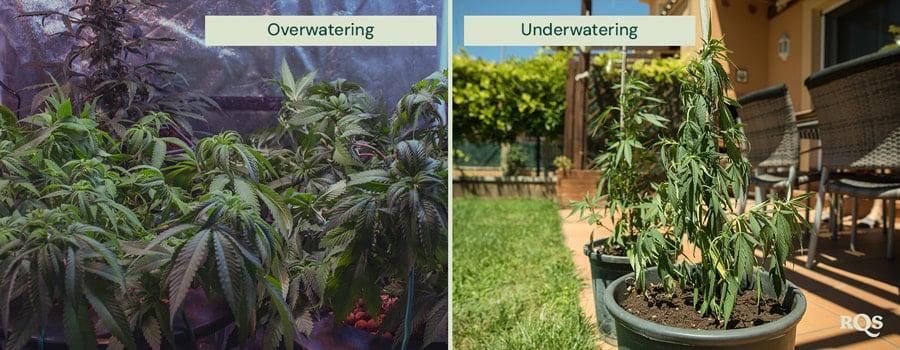
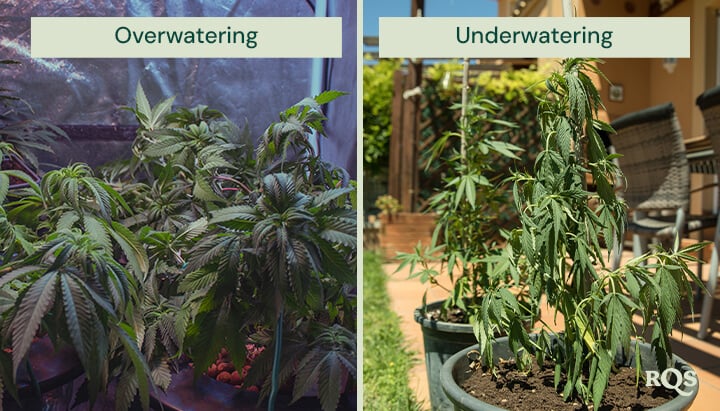
How Often Do You Need to Water Your Weed Plants?
This question actually has many different answers, as many different variables are at play. For example, temperature, humidity, and other environmental factors can all influence how often, and how much, water will be required.
However, there are telltale signs that indicate when it's time to water your plants. Again, checking the top 3 cm soil is a reliable way to identify this. Wait for this section of the soil to be completely dry before watering again in order to avoid oversaturating the soil.
Once you have done so multiple times, you should start to figure out how long it takes in between each watering, and then you can go by that length of time instead.
Paying close attention to your plant's leaves is another way to tell if it's time to water. Of course, waiting long enough for symptoms to arrive is not optimal, but any signs of wilting should immediately be followed by a dose of water.
How to Fix Overwatered Cannabis Plants
If you’ve struggled with overwatering your cannabis plants in the past, or simply want to avoid it altogether, check out some of the tried and tested preventative methods below:
- Check soil dryness: Probe the soil with your finger to a depth of roughly 3 cm. Only water again when this layer has become completely dry.
- Increase temperatures: Use heaters to drive the temperature up to 27–29°C to speed up evaporation.
- Soil amendments: Add perlite, sand, and vermiculite to your soil blend to improve drainage and prevent stagnant water around roots.
- Soil aeration: Drive chopsticks or stakes into the soil to create air pathways inside the soil.
- Fans: Use fans in your growing space to maintain airflow that will further improve evaporation rates.
- Pot selection: Smart pots and fabric pots increase aeration and drainage, preventing waterlogging.
Emergency Steps for Overwatered Weed Plants
Sometimes, it’s simply too late to apply preventative methods. If your plants are already drowning in water, there are several easy steps you can take to drain and aerate your soil:
- Start out by placing a wedge or wooden block underneath one side of your pot. This will temporarily tilt your plant and help water to drain out of the bottom of the container.
- Next, aim a fan at the surface of the soil. This technique will improve air circulation and speed up evaporation.
- If possible, raise the temperature slightly. If you don’t have a heater in your growing space, move your plant to a south-facing window or place it outdoors in direct sunlight for several hours.
- Finally, apply a generous layer of absorbent materials on top of the soil surface to soak up excess moisture, such as perlite or dry coco coir. Remove the material after it feels wet to prevent obstructing further evaporation.


Transplanting to Save Overwatered Plants
The tips above will work in most cases of overwatering. However, in extreme cases, you’ll have to remove your plant from its container. Follow the steps below to make things right:
- Place your hand flat on the surface of the soil with the stem between your index finger and middle finger. Tip the pot upside-down and gently slide the root ball out from the pot.
- Place your plant on a clean and flat surface. Dab the entire root ball with a paper towel to absorb excess moisture.
- Use a clean pair of pruning shears and cut away any signs of root rot. Remove any blackened tips, browning roots, and any section that appears slimy or smells foul.
- Grab a new container and fill it with fresh growing medium. Add 30% perlite to the mix for optimal drainage.
- Make a hole in the growing medium big enough for the root ball. Add 5 g of mycorrhizal fungi to help your root system recover and to prevent disease.
- Transplant your plant into the new container. Water the growing medium until the first sign of runoff below the pot.
How to Fix Underwatered Cannabis Plants
With overwatering solved, let’s turn our attention to underwatered weed plants. If your plants are showing signs of underwatering, such as curling and crispy leaves, it is important to act quickly but carefully to avoid causing further stress.
Dumping too much water onto your plants after a dearth can cause more harm than good. Underwatered plants often have dry, stressed roots that lose their root hairs—structures that are critical for absorption. When suddenly flooded with water, underwatered roots sometimes cannot immediately resume normal water uptake, resulting in oxygen deprivation, stomatal shock, and osmotic imbalance.
You’ll need to gradually reintroduce water to your plants to prevent stressing them out further:
- Start out by using a chopstick to create aeration holes in the soil. Then, aim to apply around 200 ml of water every 10 minutes over a 1-hour period.
- Once achieved, fill a shallow tray with water and place your pot on the tray. Bottom-watering will allow your plant to pull up water as it requires it, without the risk of oversaturating the growing medium. After several hours, you should see some of the signs of underwatering reverse; the leaves should regain their turgidity and leaflets will start to straighten out on healthier leaves.
- Continue watering as normal, but only once the top 3 cm of soil becomes completely dry. Your plant should bounce back to full health within around 3 days. In severe cases, plants may take up to one week to fully recover.
- Some of the more affected leaves may not bounce back. Use a clean pair of pruning shears to remove them.
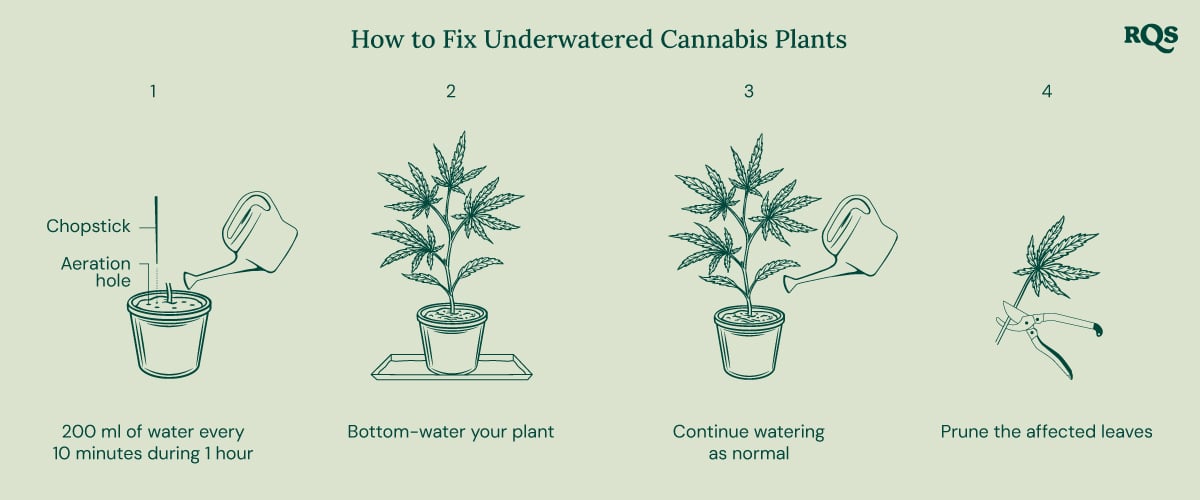

Preventing Chronic Underwatering
Now that you’re aware of how to remedy underwatering, explore the tips below to avoid encountering this situation going forward:
- Check soil moisture regularly: Keep a close eye on your soil. Check the wetness of the top 3 cm daily and make sure to add more water as soon as it feels dry.
- Correct pot size: The size of the pot you use will depend on the stain you’re growing and how big you want your plants to grow. Autos and small photoperiod strains do well in 11 l pots, whereas taller sativa-dominant plants thrive in 15–20 l pots. If you’re growing in a warm climate, bigger pots will help to prevent overwatering.
- Maintain consistent humidity: Aim for a humidity of 70% during the seedling stage, 60% during veg, and 40% using flowering. Measure humidity using a hygrometer, and use a humidifier if levels drop too low.
- Reduce temperatures: Keep your growing space at the bottom end of the temperature spectrum if you frequently encounter underwatering. Use fans and air conditioning to keep plants at a minimum of 20°C during veg and 18°C during bloom.
- Mulching: Apply mulches such as straw, worm castings, or grass clippings to the surface of your soil to lock in moisture.
Water Quality Is Paramount
You’re now equipped with all the knowledge you require to keep your cannabis plants in perfect equilibrium when it comes to watering. You know how to prevent underwatering and overwatering, and how to manage both conditions when they show up.
While this information is crucial, you also shouldn’t ignore water quality. Much like watering frequency, the quality of water you use plays an important role in plant health.
Cannabis plants are made up of around 90% water, which they use to carry out key physiological functions such as transpiration and photosynthesis. Using poor-quality water can disrupt these mechanisms and prevent plants from reaching their full genetic potential.
So, what makes water high quality? And how can you determine this? Continue reading to discover the answers to these vital questions.
The Role of pH
One important factor when it comes to water quality is pH.
pH is a numeric scale used to measure the acidity or alkalinity of a solution, with the middle value of 7 representing neutral. Numbers less than 7 represent acidity and numbers above 7 display alkalinity.
pH that is either too high or too low can cause problems in cannabis plants, as the pH of the water source can dictate a plant's ability to absorb nutrients. Water with too low or too high of a pH can affect the pH of your grow medium over time, which results in symptoms that look identical to those caused by certain nutritional deficiencies, despite ample amounts of nutrients in the soil.
Cannabis plants tend to thrive at a pH of around 6.5. pH can be measured extremely easily by simply using a pH meter to test a runoff sample. Runoff is water that drains from your grow container, having passed through your growing medium. If the pH is either too high or too low, pH up and down products can be used to return it to normal levels.


PPM and Water Quality
PPM is another important factor when it comes to water quality. PPM, or parts per million, is a method of measuring the amount of minerals that have dissolved into the water source being used. So, a reading of 90 PPM will indicate that there are 90 milligrams per litre of minerals present within the water source.
Being aware of the PPM within water allows growers to avoid giving their plants too many or too few minerals. A lack of minerals may lead to deficiencies, whereas too many may cause burning to occur.
Cannabis plants prefer a PPM of around 500 when in the vegetative phase, and around 1000 during the flowering.
TDS meters, devices that measure total dissolved solids, can be used to measure the PPM of a water source. Monitoring PPM is quite advanced and, while useful, is not essential for novices finding their feet. Just bear it in mind as you look to expand your knowledge and skills.
Reverse Osmosis Water
Although the total dissolved solids within your water might be adequate, not all substances within a water source are beneficial for your cannabis crop. Water might be contaminated with other substances such as pollutants and bacteria.
Reverse osmosis filters are a great option to remove almost everything within a water source, allowing growers to add back only what they want to introduce to their plants. Reverse osmosis filters are capable of removing between 95–99% of dissolved salts within a water sample and are therefore a standard method of cleaning water on an industrial scale. Once again, using reverse osmosis water is an advanced growing technique, so it is not essential for beginners.
Test Your Water Runoff
To produce healthy plants, you need to keep a close eye on the amount of nutrients your plants are receiving. To do this, use trays to catch the runoff when you water your plants, and analyse both its pH and PPM.
Cannabis plants tend to thrive at a pH of around 6.5. To check your pH, simply test the runoff using a pH meter. Our pH tester by Hanna Instruments is super simple to use and offers fast and accurate readings. If your pH is either too high or too low, you can use pH regulators to bring it up or down.
With the above in mind, you should be well on your way to understanding how overwatering and underwatering affect your plants, as well as overall water quality in general.
Cannabis Plant Watering and Water Quality: FAQ
- What are the signs of overwatering cannabis?
- The signs of overwatered cannabis plants include wet and soggy soil, soft and limp leaves, downward-curling leaves, and stunted growth.
- How do you fix overwatered weed plants?
- You can fix overwatered plants by using fans and higher temperatures to enhance evaporation rates. In severe cases, you should transplant them into new pots.
- What do underwatered cannabis plants look like?
- Underwatered cannabis plants exhibit dry and crispy leaves, yellow and brown discolouration, leaves that curl upwards, and stunted growth.
- How long does it take for overwatered plants to recover?
- Overwatered plants can take anywhere between 3–7 days to fully recover based on the severity of their condition.
 Grow Guide Topic Finder
Grow Guide Topic Finder
- Growing cannabis step by step
- Cannabis growing basics
- Choosing your seeds
- How to germinate seeds
- The cannabis vegetative stage
- The cannabis flowering stage
- Harvesting cannabis
- Trimming, drying, and curing
- Choosing pots and soil
-
Growing indoors
- A Complete Overview Of Growing Cannabis Indoors
- Cannabis Cultivation Tips: How To Set Up Indoor Grow Lights
- How Many Cannabis Plants Can You Grow Per Square Metre?
- Indoor Cannabis Growing: Relative Humidity and Temperatures
- Hydroponics Cannabis Growing Guide (with diagrams)
- Cannabis Micro Growing: Growing Great Weed in Tiny Spaces
- Growing outdoors
- How to grow autoflowering cannabis
- Cannabis nutrients and pH
- Cannabis troubleshooting: Nutrients
-
Cannabis troubleshooting: Growing
- Cannabis Seed Germination — Troubleshooting Guide
- How to Deal With Pythium (Root Rot) in Cannabis Plants
- Slow Cannabis Plant Growth And What You Can Do About It
- How to Deal With Leggy Cannabis Seedlings
- Watering Your Cannabis: How to Fix Overwatering and Underwatering
- Understanding Male, Female, And Hermaphrodite Cannabis
- Identifying and Treating Common Cannabis Ailments
- How To Revive a Sick Cannabis Plant
- How to Avoid Mouldy Weed During Drying and Curing
- How to Prevent and Treat Dry and Crispy Cannabis Leaves
- What Cannabis Leaves Can Tell You
- Causes and Solutions for Yellow Cannabis Leaves
-
Cannabis Strains Grow Report
- HulkBerry Automatic Grow Report
- Blue Cheese Auto Grow Report
- Purple Punch Automatic Strain Grow Report
- Triple G Automatic Grow Report
- Do-Si-Dos Automatic Grow Report
- Green Gelato Automatic Grow Report
- Haze Berry Automatic Grow Report
- Purple Queen Automatic Grow Report
- Cookies Gelato Automatic Grow Report
- Sherbet Queen Automatic Grow Report
- Sweet Skunk Automatic Grow Report
- Medusa F1 Grow Report
- Cannabis plant training
-
Weed growing tips
- The Cannabis Plant Anatomy
- How to preserve seeds
- How Much Sunlight Do Outdoor Cannabis Plants Need To Grow?
- How to Control and Prevent Stretching in Cannabis Plants
- My Cannabis Plants Are Growing Too Tall: What Should I Do?
- Should You Worry About Purple Or Red Cannabis Stems?
- What To Do When Your Indoor Cannabis Won’t Flower
- How To Protect Your Cannabis Plants From Heat Stress
- How To Tell If Your Female Cannabis Plant Has Been Pollinated
- Growing Medical Marijuana
- Bud Washing: How to Clean Your Weed
- Understanding Cannabis Yield per Plant




























